New Species Discovered in Ghana
Posted by: Loren Coleman on December 7th, 2007

A new species of tickspider (Ricinoides sp. n.). Photo by Piotr Naskrecki (CI)
Conservation International has announced findings from their 2006 expedition to Ghana’s Atewa Range Forest Reserve (Atewa) led by CI’s Rapid Assessment Program (RAP), which include news of nine new species discoveries. The report was released to the public on December 6, 2007.
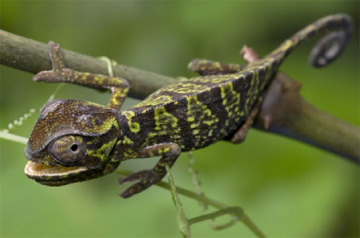
Chameleon Chamaeleo gracilis. Photo by Piotr Naskrecki (CI)
The RAP discoveries include a Critically Endangered frog species (Conraua derooi) whose presence in Atewa may represent the last viable population in the world; an unusually high 22 species of large mammals and six species of primates including two species of global conservation concern: Geoffroy’s pied colobus (Colobus vellerosus) and the olive colobus (Procolobus verus); 17 rare butterfly species; six bird species of global conservation concern including the brown-cheeked hornbill (Bycanistes cylindricus) and the Nimba flycatcher (Melaenornis annamarulae), recorded for the first time in Ghana; and nine species new to science: a tickspider and eight species of katydids.
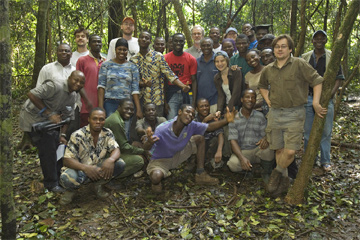
The Atewa RAP team. Photo by Piotr Naskrecki (CI)
Between June 6 – 24, 2006, a team of 22 scientists, post-graduate students and assistants from Ghana and abroad surveyed the 58,472 acre (23,665 hectare) Atewa tract in south-eastern Ghana, just two hours from the capital Accra. The scientists found an intact forest ecosystem, which is unusual and significant for West Africa, where most forests are highly fragmented and disturbed.
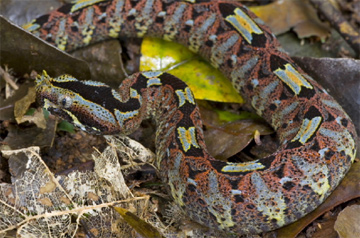
Rhinoceros viper (Bitis nasicornis). Photo by Piotr Naskrecki (CI)
Established as a national forest reserve in 1926, and since as one of Ghana’s Globally Significant Biodiversity Areas, Atewa’s importance has long been recognized because it contains the headwaters of three river systems, essential sources of domestic, agricultural and industrial water for local communities and many of Ghana’s major population centers, including Accra.
The aquatic Conraua derooi is Critically Endangered and may have its largest populations in the Atewa Range Forest Reserve. Photo by Piotr Naskrecki (CI)
Findings from Conservation International’s Atewa RAP report include:
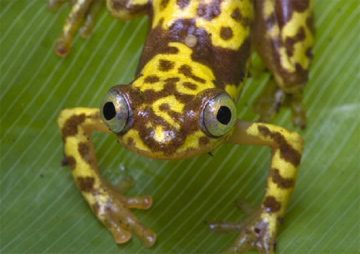
Frog (Afrixalus vebekensis). Photo by Piotr Naskrecki (CI)
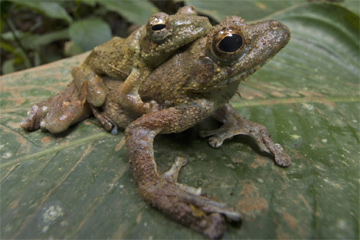
Tree frogs in amplexus (Chiromantis rufescens). Photo by Piotr Naskrecki (CI)
A Critically Endangered frog (Conraua derooi) whose presence in Atewa may represent the last viable population in the world.
A new species of tickspider (pictured at top) whose lineage is as old as the dinosaurs. This strange little creature looks like a cross between a spider and a crab, and males have their reproductive organs on their legs. They are considered quite rare, with only 57 other species known from this group throughout the world.
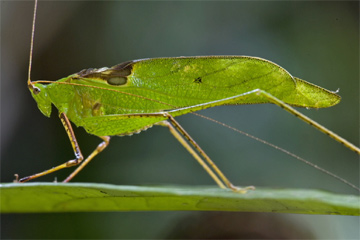
A new species of katydid (Tetraconcha sp. n.). Photo by Piotr Naskrecki (CI).
The highest diversity of katydids (aligned with the grasshoppers) in all of Africa, including eight species new to science, making 13% of all species of katydids in Atewa new to science.
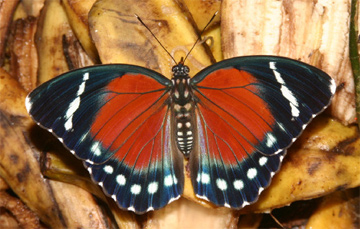
The Green Orange Forester – Euphaedra zampa (female; the male is metallic green) is endemic to the forests west of the Dahomey Gap. It is rare everywhere in Ghana except Atewa, where can be the commonest Euphaedra. Photo by Szabolcs Sáfián (CI).
The highest diversity of butterflies in Ghana, featuring 575 of the 925 species known to occur in Ghana – which is 62% of Ghana’s butterfly fauna and twice the number of butterflies found in Europe.
Seventeen species of rare butterflies, half of which are found only in Atewa or one other site in Ghana, including the magnificent Papilio antimachus, whose wingspan is the widest in the world.
A butterfly (Mylothris atewa) that is found nowhere else in the world and has been proposed as globally Critically Endangered. This status awaits confirmation by IUCN. The RAP report contains the first photo of this species in the wild.
Ten mammal species of global and national conservation concern, including the IUCN Red Listed monkeys: Geoffroy’s pied colobus (Colobus vellerosus) and the olive colobus (Procolobus verus).
An unusually high 155 bird species. Six species of global conservation concern including the brown-cheeked hornbill and the Nimba flycatcher (first time recorded in Ghana).
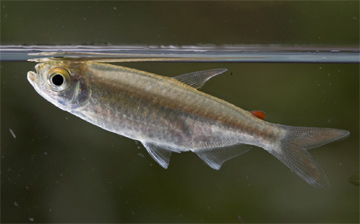
African tetra (Micralestes occidentalis). Photo by Piotr Naskrecki (CI).
Nineteen fish species of significant potential value in the aquarium trade. These species indicate that the streams run through high quality, intact forest, which is becoming exceedingly rare in West Africa.
The only tree fern species (Cyathea manniana) found in Ghana. Other places where similar species are found include forests in Brazil and Madagascar.
Sources: Press releases and other material from wire services, Conservation International, Science Daily, and Mongabay.
About Loren Coleman
Loren Coleman is one of the world’s leading cryptozoologists, some say “the” leading living cryptozoologist. Certainly, he is acknowledged as the current living American researcher and writer who has most popularized cryptozoology in the late 20th and early 21st centuries.
Starting his fieldwork and investigations in 1960, after traveling and trekking extensively in pursuit of cryptozoological mysteries, Coleman began writing to share his experiences in 1969. An honorary member of Ivan T. Sanderson’s Society for the Investigation of the Unexplained in the 1970s, Coleman has been bestowed with similar honorary memberships of the North Idaho College Cryptozoology Club in 1983, and in subsequent years, that of the British Columbia Scientific Cryptozoology Club, CryptoSafari International, and other international organizations. He was also a Life Member and Benefactor of the International Society of Cryptozoology (now-defunct).
Loren Coleman’s daily blog, as a member of the Cryptomundo Team, served as an ongoing avenue of communication for the ever-growing body of cryptozoo news from 2005 through 2013. He returned as an infrequent contributor beginning Halloween week of 2015.
Coleman is the founder in 2003, and current director of the International Cryptozoology Museum in Portland, Maine.










Awesome. Stunning photographs to boot. I am quite pleased with the number of new species discoveries rolling in in recent days. Hope it keeps up.
How many times does someone have to go somewhere we’ve been before to find new species, before the world realizes we don’t know squat about what is really out there? These are awesome!
WOW! This is incredible!
I find this very fascinating, especially the katydid and the crab spider! Thanks Loren!
Great stuff! I’m not sure how many people would agree with me, but that Rhino Viper is a beauty. About that frog, Conraua derooi-is that related to the Goliath Frog?
Excellent news, Loren! Thanks for passing this along. I agree, great pictures!
hey loren excellent new article about new species of animals discovered in ghana. thanks bill green 🙂
I agree with Saint Vitus that rhino viper is truly a beautiful creature.
Wow, 22 species of large mammals. Thats insane.
I’m digging the Tickspider and Rhinoceros viper
I want to know about the other 20 species of large mammals!
Two hours from the capital of the country, in a part of Africa most of us have long since given up as overrun by humanity.
We don’t know squat about this planet.
I once quoted Keel here to the effect that we know more about the moon than about our own oceans. The same applies to Africa and other landmasses. So all of you are right. Dinosaurs could be found in the dark heart of Africa for all we know. Improbable, but not impossible.
I love that Rhinoceros viper (Bitis nasicornis). And the Frog (Afrixalus vebekensis). The tickspider is scary as heck.
Rhinoceros viper is stunning!
6 species of primate!! That’s pretty amazing (not to discount the other findings, they are important as well) especially if the previous commentor is correct and this location is only two hours outside of a large human population.
Gives me hope that more mammalian species will be found in North America.
what does that tickspider eat?
DWA- I’m curious about what the species of large animals are too! Anyway, I go as far as to say we don’t know squat about this planet, but we certainly don’t know as much as we think we do. 🙂
Very Kool indeed. I think that snake has to be one the most beautiful snakes I have ever seen. Look at the color on that thing. It almost looks like it has tribal markings on it.
sschaper responds:
what does that tickspider eat?
Probably what ever it sinks it fangs into.
I wouldn’t want one of those biting into me.
DARHOP- I think you are probably right about the tickspider’s diet. I’m no expert on spiders, but to the best of my knowledge, most will eat whatever they can manage to catch. I saw an incredible video clip of a spider actually subduing a bat far larger than itself in it’s web and proceeding to dig in. Talk about some heartburn. 🙂